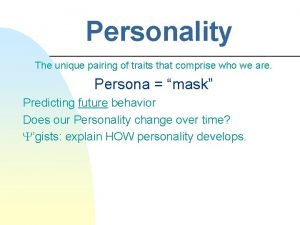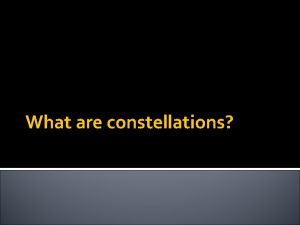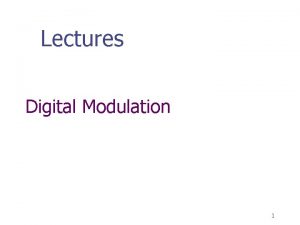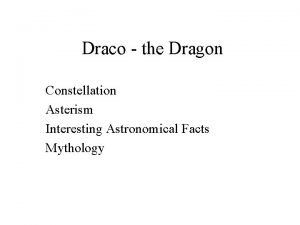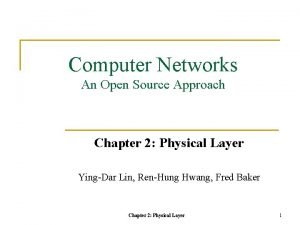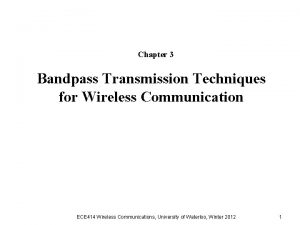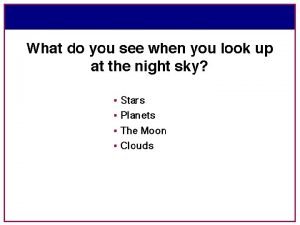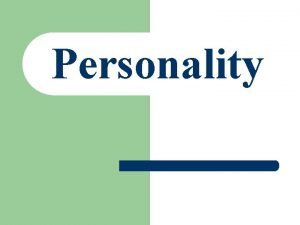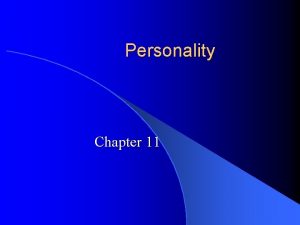Personality Assessment Personality Definition an individuals unique constellation












- Slides: 12

Personality Assessment • Personality Definition: an individual’s unique constellation of psychological states and traits • Traits: Guilford (1959), “An distinguishable, relatively enduring way in which one individual varies from another. ” • States: transitory exhibition of some personality trait • Types: constellation of traits & states that is similar in pattern to one identified category of personality taxonomy, e. g. , Type A, personality profiles

Basic Characteristics of Personality Assessment Methods • Personality v. IQ & Achievement tests – Typical v. maximum performance tests – Stability of constructs of interest • Degree of inference in assessment methods – Behavioral v. “traditional” v. projective • Interpretation approaches – Clinical v. actuarial

Methods of Developing Assessment Methods • Logic/Reason – Face validity, content-oriented approach • E. g. , DSM questionnaires • Theory – Questions reflect theory about personality & human behavior • E. g. , Self-Directed Search, EPPS

Methods of Developing Assessment Methods (cont. ) • Data Reduction methods – Factor analysis to place items to scales • E. g. , Cattell & 16 PF, Children’s Personality Questionnaire, NEO PI-R (Big 5, Neuroticism, Extraversion, Openness, Agreeableness, Conscientiousness) • Empirical Criterion Keying – Can items/scales distinguish among groups? • E. g. , MMPI

MMPI Overview • Psychiatric patients v. visitors • 567 true-false items • 10 clinical scales that could differentiate the groups • “validity” scales • Several “research”/content scales developed over the years

MMPA-2 • Items rewritten – Eliminated “objectionable” wording • Added items – Drug abuse, Type A, attitudes toward work • 3 new validity scales • New content scales, clinical scales the same • Larger & more representative normative sample

Projective Assessment • Psychodynamic origination • Projective hypothesis – When confronted with ambiguous stimuli subjects will create structure which reveals information about their personalities, needs, drives, etc.

Projectives (cont. ) • Defining characteristics – Lack of stimulus structure – Multiplicity of responses permitted – Absence of right or wrong answers • Assumptions – Because they are ambiguous, they elicit more meaningful information; – They are less susceptible to faking – Reveal more unconscious aspects of personality

Examples of projectives • Rorschach – 10 ink blots – Exner comprehensive scoring system • Free association and inquiry phases • What are characteristics of response? – E. g. , location, popular responses, perseveration

Storytelling/Apperception tests • Thematic Apperception Test (TAT) – Murray’s Needs-Press theory – What’s happening in the picture? What events led up to the scene? What will happen next? What are the people’s thoughts, feelings, etc. – Hero, Needs, press, outcomes, themes • Children’s Apperception Test, Robert’s Apperception Test • Modifications for individuals of differing ethnic backgrouns

Projective drawings • • Overall appraisal + “sign” approach Draw a Person House-Tree-Person Kinetic Family Drawing

Evaluation of Projectives • Are they tests? – Can they be held to psychometric standards? • Assumptions have not really held up. • Can be influenced by situational variables. Stimuli not as ambiguous as assumed. • Psychometrics not been demonstrated despite years of study.
 An individual's unique constellation
An individual's unique constellation Not having siblings
Not having siblings Unique pairing personality
Unique pairing personality Defintion of constellation
Defintion of constellation Probability symbol
Probability symbol Mazzaroth
Mazzaroth Facts about the draco constellation
Facts about the draco constellation Ursa major facts
Ursa major facts Smallest constellation
Smallest constellation Ask modulation constellation diagram
Ask modulation constellation diagram Constellation diagram bpsk
Constellation diagram bpsk Ask modulation constellation diagram
Ask modulation constellation diagram Astronomical coordinates
Astronomical coordinates


